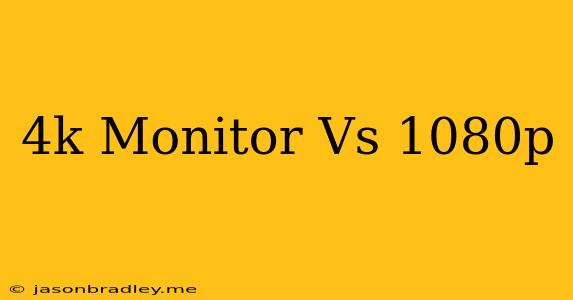4K vs 1080p Monitors: Which is Right for You?
Choosing the right monitor can be a daunting task, especially with the wide range of options available. Two of the most popular resolutions are 1080p (1920x1080 pixels) and 4K (3840x2160 pixels). Both offer a great visual experience, but they come with their own set of pros and cons. This article will help you understand the key differences between 4K and 1080p monitors and guide you towards the best choice for your needs.
Resolution and Pixel Density
The most obvious difference between 4K and 1080p is the resolution. 4K offers four times the pixels of 1080p, resulting in a much sharper and more detailed image. This is especially noticeable on larger screens, where the extra pixels translate into a more immersive and less pixelated experience.
1080p monitors offer a good balance between sharpness and affordability, particularly for smaller screen sizes. They are also more widely available and compatible with a wider range of devices.
Image Quality
4K monitors generally offer a better image quality due to their higher resolution, resulting in more realistic colors, sharper text, and smoother gradients. This is particularly noticeable when viewing high-resolution content such as 4K movies or gaming at high settings.
1080p monitors are still perfectly capable of delivering a good viewing experience, especially when paired with a smaller screen size. The lower resolution might not be as noticeable on smaller displays.
Price
4K monitors are generally more expensive than 1080p monitors due to the more advanced technology required to produce them. However, prices for 4K monitors have been steadily dropping, making them more accessible than ever before.
1080p monitors are more budget-friendly, offering a great value for money, especially for casual users or those on a tighter budget.
Gaming and Performance
4K gaming can be a demanding experience requiring a powerful graphics card to achieve high frame rates. However, the visual benefits of 4K gaming are undeniable, offering a truly immersive and detailed experience.
1080p gaming is less demanding on hardware, making it a more accessible option for gamers with less powerful systems. You can achieve higher frame rates at 1080p, leading to smoother gameplay.
Usage and Preferences
4K monitors are best suited for tasks that require high detail and sharpness, such as photo editing, video editing, graphic design, and watching 4K content. They are also a good choice for gamers who prioritize visual fidelity over frame rate.
1080p monitors are great for everyday tasks like web browsing, office work, and casual gaming, offering a good balance between sharpness, performance, and affordability.
Conclusion
Choosing between a 4K and 1080p monitor ultimately depends on your individual needs and preferences. If you are looking for the best possible image quality, a 4K monitor is the way to go, but be prepared to pay a premium and invest in a powerful system to take advantage of its capabilities. If you are on a budget or prioritize performance over image quality, a 1080p monitor is a great value option.
Remember to consider your screen size, your primary use case, and your budget when making your decision. No matter which resolution you choose, you can be sure of a great viewing experience.
